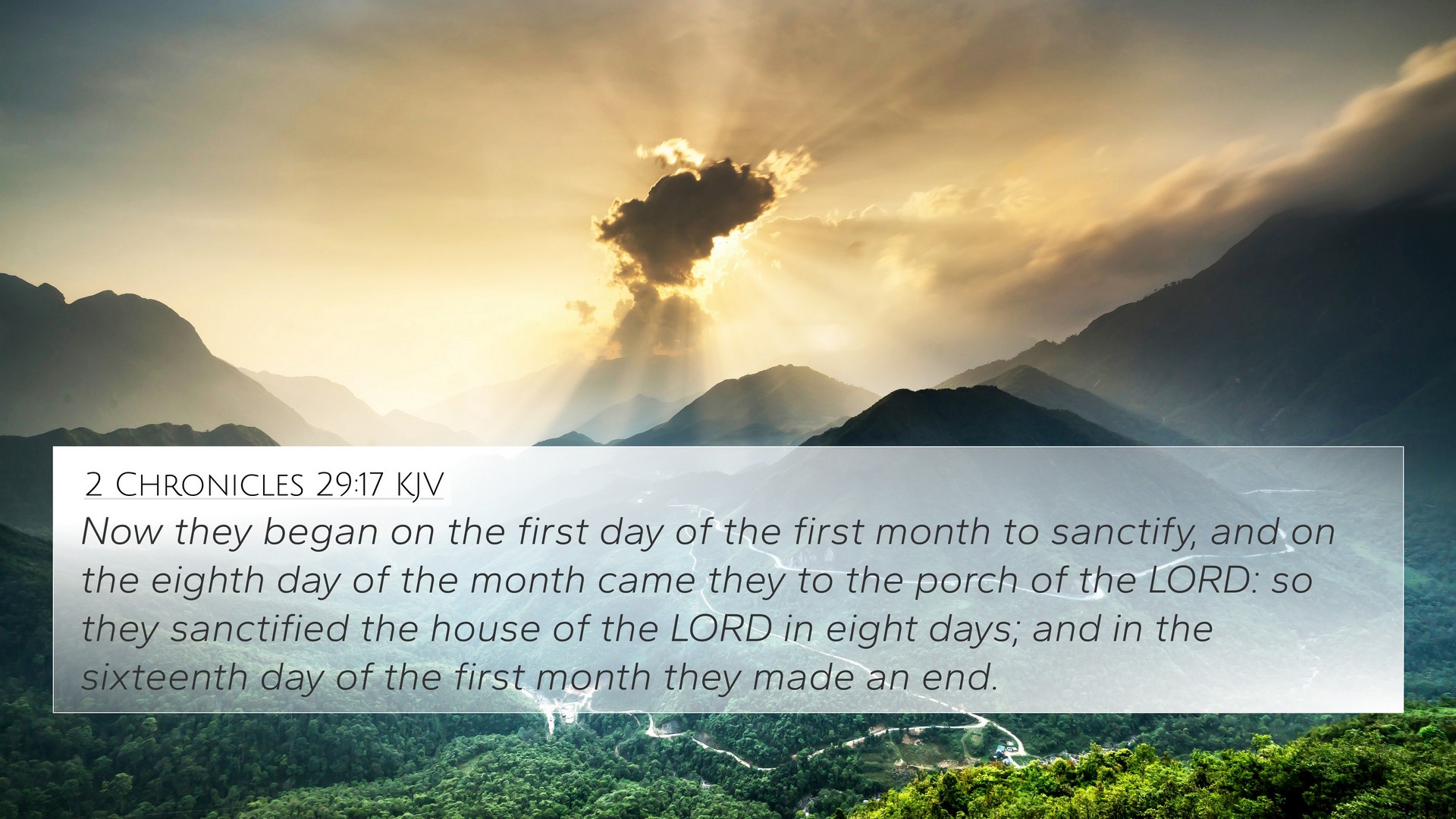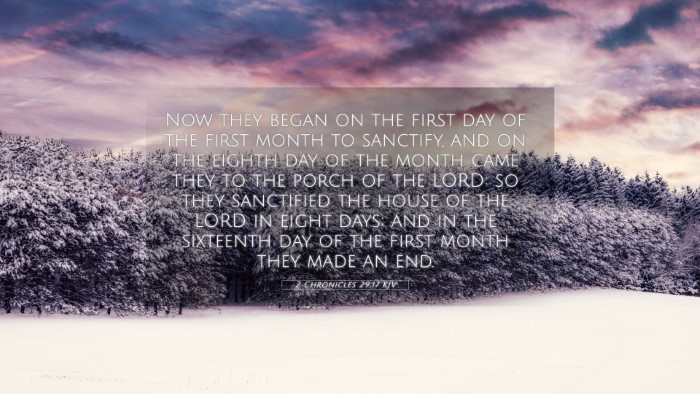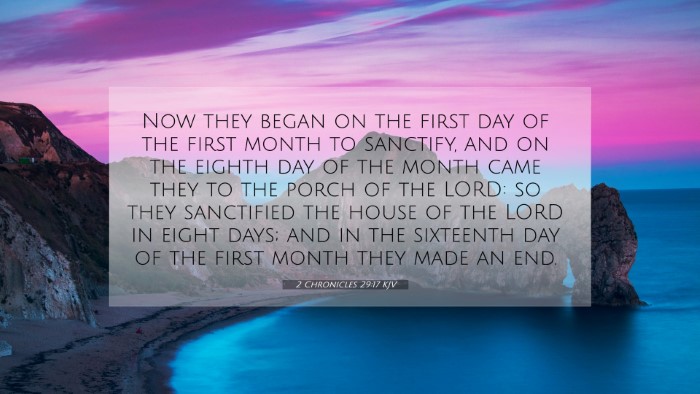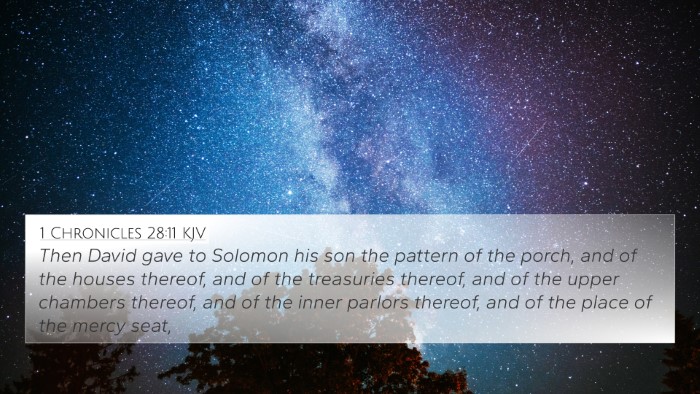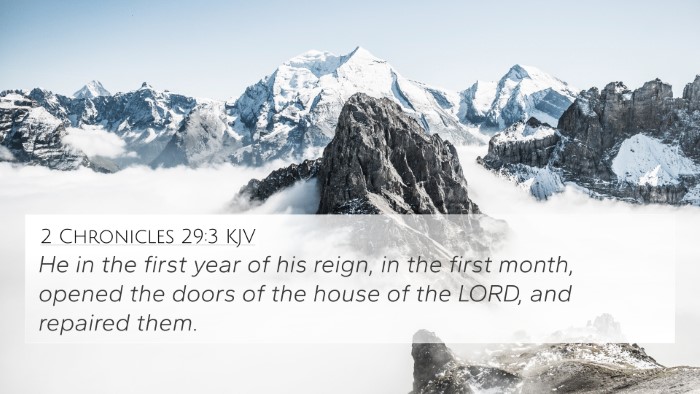Understanding 2 Chronicles 29:17
2 Chronicles 29:17 states:
"Now they began the consecration on the first day of the first month, and on the eighth day of the month they came to the porch of the Lord. So they consecrated the house of the Lord in eight days, and finished on the sixteenth day of the first month."
Context and Background
This verse takes place during the reign of King Hezekiah, a reformative king of Judah, who initiated a revival of worship in Jerusalem. Contextually, this chapter describes the purification and restoration of the temple after years of neglect.
- Historical Significance: Hezekiah's reforms were a crucial turning point in the history of Judah, aligning worship practices with the Mosaic Law.
- Key Theme: Restoration – both physical and spiritual restoration of God’s dwelling place.
Bible Verse Parallels
This verse can be cross-referenced with other scriptures that discuss temple consecration and the significance of spiritual restoration, illustrating a thematic connection throughout the Bible.
- 1 Kings 8:63 - Solomon’s dedication of the temple.
- 2 Chronicles 30:5 - Hezekiah calling for a Passover observance.
- Ezra 3:10 - The rebuilding of the temple after exile.
- Nehemiah 12:27 - Dedication of the wall of Jerusalem.
- Hebrews 9:24 - Christ as our high priest in the greater temple.
- Isaiah 60:7 - The glory of the Lord’s house being restored.
- Matthew 21:12 - Jesus cleansing the temple.
- Revelation 21:3 - The ultimate presence of God with His people in the New Jerusalem.
Exegesis and Commentary Insights
The commentaries by Matthew Henry, Albert Barnes, and Adam Clarke provide valuable insights into the meaning of this passage:
- Matthew Henry: Emphasizes the importance of purification before God's presence, highlighting that the people took time to prepare the temple, reflecting their reverence and commitment to right worship.
- Albert Barnes: Notes the careful organization of the consecration process, denoting that meticulous order and proper timing were essential in restoring the worship practices.
- Adam Clarke: Discusses the spiritual significance of the eight days of consecration, associating it with completeness and the importance of dedicating oneself fully to God.
Thematic Connections
This verse contributes to understanding several key themes, including:
- Dedication: The act of dedicating the temple serves as a metaphor for dedicating one's life to God.
- Consecration: The process reflects a transformative journey, inviting believers today to consider their own spiritual life and dedication.
- Community Involvement: Hezekiah’s reforms were a collective effort, emphasizing the role of community in worship.
Tools for Bible Cross-Referencing
To deepen one’s understanding of this verse, utilizing tools for Bible cross-referencing is essential. Various resources and methods can facilitate deeper insights:
- Bible Concordance: Look for key words that link to the themes of restoration and worship.
- Bible Cross-Reference Guide: Guides often provide structured paths for thematic study across both Testaments.
- Bible Reference Resources: Resources like commentaries and dictionaries can provide historical and cultural context.
Cross-Referencing Biblical Texts
Understanding 2 Chronicles 29:17 in light of other scripture enhances clarity and allows for a more profound interpretation. The following principles and methods can aid in effective cross-referencing:
- Identify Themes: Look for shared themes among verses, such as worship, holiness, and restoration.
- Study Cross-Referenced Themes: Explore themes like worship throughout the Psalms in conjunction with teachings from the New Testament.
- Inter-Biblical Dialogue: Engage with dialogue between different authors in the Bible. The connections between prophetic words and apostolic teachings can shed light on 2 Chronicles 29:17.
Conclusion
2 Chronicles 29:17 serves as an anchor for understanding how the people of Israel approached worship and the significance of consecration in their lives. The connections drawn from public domain commentaries provide a multi-dimensional view of the verse, inviting readers to explore its meanings in light of broader scriptural themes.
By engaging in cross-referencing and considering related verses, one can deepen their understanding of God’s expectation of holiness and dedication in worship, offering a template for spiritual practices today.
